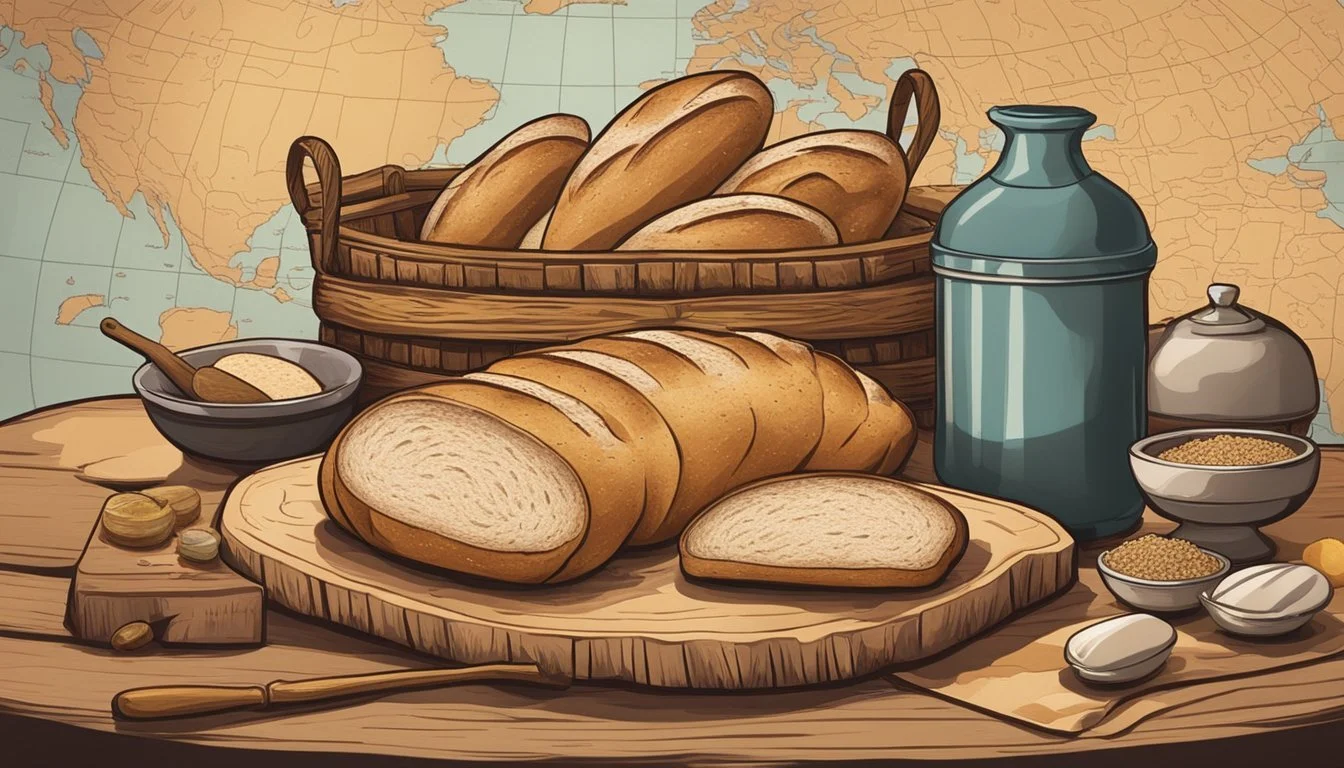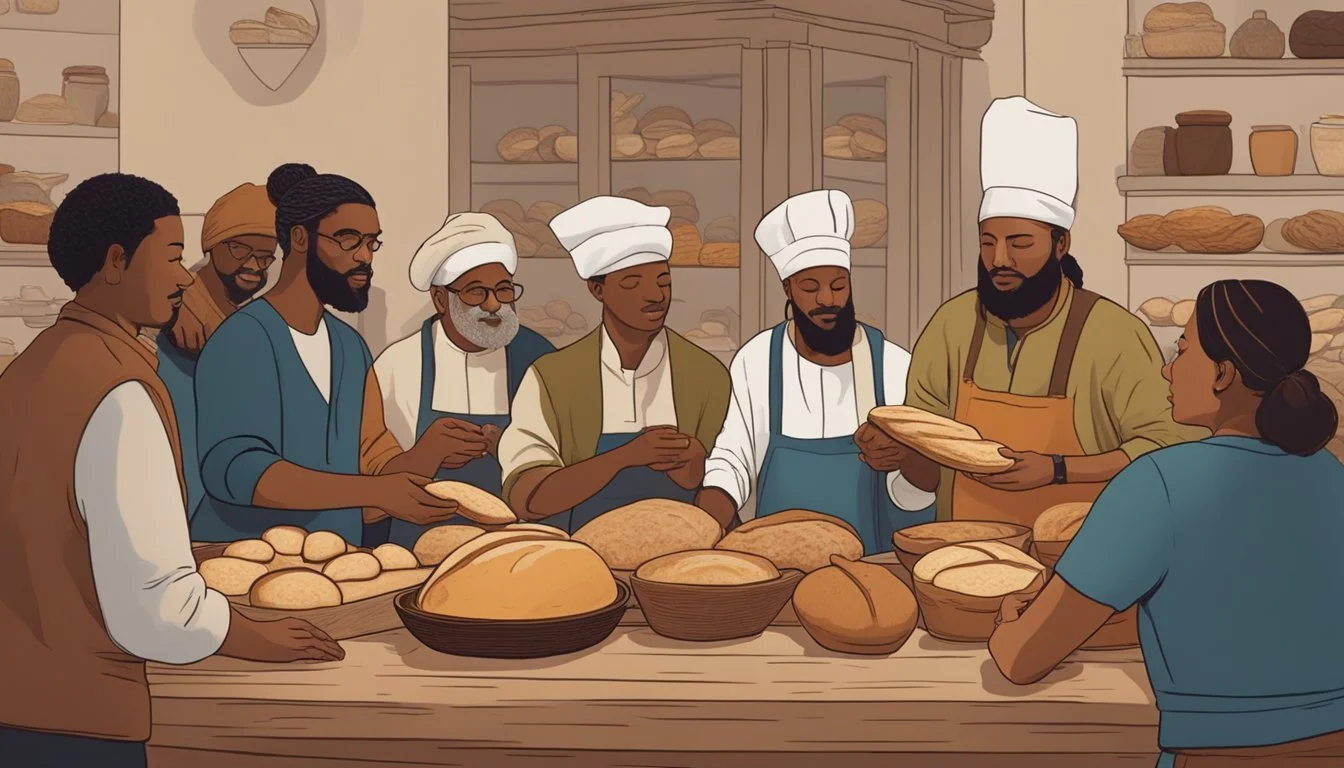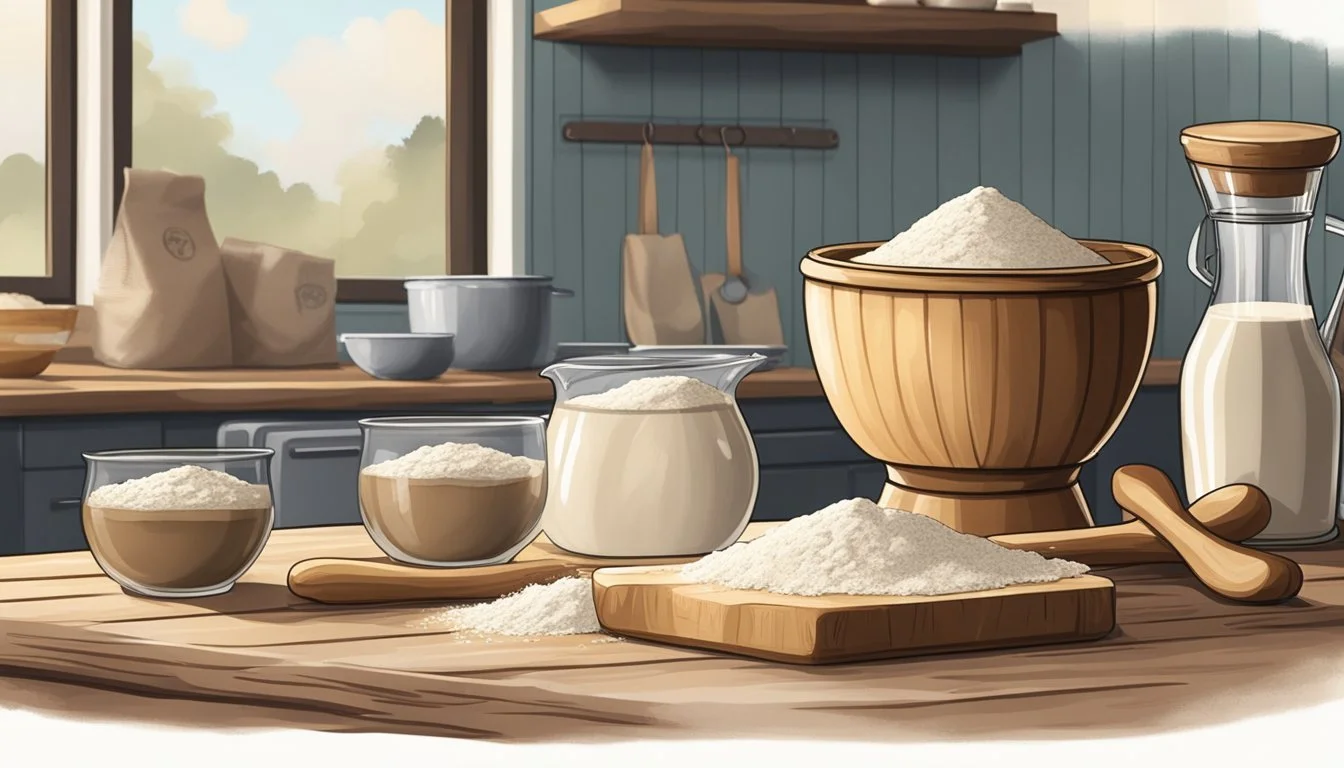The History of Sourdough Bread Across Cultures
A Global Tradition Unveiled
Sourdough bread (What wine goes well with bread?), with its distinctive tang and airy texture, harbors a rich history that traverses the globe and dates back to ancient times. It is believed that sourdough was first made in Egypt around 3000 BC, inadvertently discovered when dough left out became fermented by naturally occurring yeast and bacteria. This early form of bread-making gradually spread from Egypt to other cultures. The Greeks and the Romans, who were notable for their contributions to the evolution of bread and oven technologies, adopted and further refined sourdough techniques.
The resilience and simplicity of sourdough fermentation, relying on wild yeast and lactic acid bacteria, made it a staple before the commercialization of baker's yeast. Its preparation involves a living culture or 'starter', which is a symbiotic culture of bacteria and yeast that ferments and causes the dough to rise. This natural leavening process not only imparts sourdough with a unique flavor but also offers certain nutritional benefits, such as improved digestibility and a longer shelf-life compared to other breads.
Despite the decline in sourdough baking with the advent of commercial yeast in the 19th century, the 20th and 21st centuries witnessed a resurgence in its popularity. Artisanal sourdough bread has become particularly sought after, and it remains a symbol of the baking trade's rich heritage – a tradition that reflects the continuity of shared human experience across cultures. This renewal of interest underscores a growing appreciation for the craft of traditional baking and the desire for naturally fermented foods. (What wine goes well with fermented foods?)
Origins of Sourdough Bread
The history of sourdough bread is a tale of ancient innovation and cross-cultural exchange, beginning with its accidental discovery and culminating in its spread across civilizations.
Ancient Practices and Societies
In the annals of baking history, sourdough stands out for its longevity and ubiquity. Ancient societies relied on the natural fermentation of dough to produce bread, a staple of their diet. The art of sourdough baking began with a simple mixture of flour and water. Before the use of commercial yeast, bakers depended on this mixture to capture wild yeast and bacteria from the environment. This combination would ferment, causing the dough to rise and acquire its characteristic sour taste.
Grains used:
Wheat
Oats
Rye
The practice of sourdough preparation was not uniform; different grains were favored by various cultures, leading to a diverse range of bread styles and flavors. Sourdough's resilience and ability to ferment under varied conditions made it a reliable option for bread-making throughout ancient civilizations.
Fertile Crescent to Ancient Egypt
The journey of sourdough bread can be traced back to the Fertile Crescent, an arc of plentiful land in the Middle East that was ideal for agriculture, including the cultivation of grain. However, it was in Ancient Egypt where sourdough bread truly flourished. The Egyptians are credited with the widespread use of sourdough, mastering the process by 1500 BC. They discovered the leavening potential of sourdough when dough left exposed naturally fermented, giving rise to lighter and airier loaves. Their techniques set a template that would echo through the annals of baking history.
Fermentation Discovery:
Accidental exposure to wild yeasts
Natural leavening method
Enhanced bread texture and flavor
Ancient Egyptians developed and refined sourdough baking, turning it into a consistent and purposeful practice. The mastery of sourdough in Egypt laid the groundwork for its adoption and adaptation by subsequent civilizations, firmly embedding it into the culinary traditions of the world.
Cultural Significance
Sourdough bread has woven its way through the fabric of many cultures, acquiring unique meaning and traditions along its journey.
Sourdough in Ancient Greece and Rome
Sourdough held a prestigious place amidst the ancient Greeks, seen as a symbol of civilization and sustenance. Greek bakers, masters in the craft, passed their elaborate baking techniques to the Romans. The Roman government underscored its importance by providing citizens with 320,000 free loaves each month, reflecting bread's status as a societal pillar.
Sourdough Throughout Europe
In Europe, the tradition of sourdough baking varied from country to country, with distinct regional styles emerging. For instance, French sourdough, known as Pain au Levain, became integral to the country's culinary identity. Sourdough's significance in European culture spanned both socio-cultural and socio-economic aspects, making it a common thread in the continent's gastronomic tapestry.
Sourdough and the Gold Rushes
During the California Gold Rush, sourdough became not just a staple, but a symbol of the miners' resilience. In the rough frontier life of San Francisco, those successful miners were often called "sourdoughs," tying their identity to this hearty bread. The Klondike Gold Rush carried the traditions northward, where sourdough remained a reliable food source and a cultural link for the miners braving the harsh conditions.
The Science of Sourdough
The quintessential characteristics of sourdough bread arise from the complex interplay between wild yeast and lactic acid bacteria during the fermentation process. This interaction not only leavens the dough but also contributes to the bread’s distinct taste and texture.
Wild Yeast and Lactic Acid Bacteria
Wild yeast, predominantly Saccharomyces cerevisiae, and various lactic acid bacteria are the two key players in a sourdough culture. In contrast to commercial yeasts, wild yeasts are naturally present in flour and the environment. They thrive alongside lactic acid bacteria in a sourdough starter, the fermented dough which is traditionally used to make sourdough bread.
Microbial Agent Role in Sourdough Wild Yeast Fermentation, gas production Lactic Acid Bacteria Acid production, flavor, structure
Wild yeast is responsible for the leavening process. It consumes the sugars present in the flour, releasing carbon dioxide and alcohol in the process. This forms the bubbles that make the dough rise. The lactic acid bacteria produce lactic and acetic acid, giving sourdough its characteristic tang and improving the dough's structure by strengthening the gluten network.
Fermentation and Leavening Process
During fermentation, a symbiotic relationship between the yeast and bacteria in the sourdough culture is essential. This process typically occurs in two stages: the first is dominated by bacteria growth, which lowers the dough's pH, making it more acidic. Subsequently, the environment becomes ideal for yeast growth, resulting in the leavening of the dough as the yeast produces gas.
Fermented dough becomes leavened bread through this gradual process:
Mixing of the sourdough starter with flour and water.
The starter's yeast begins consuming available sugars, producing CO2.
Dough rises as CO2 bubbles expand, stretching the gluten network.
Acids produced by bacteria confer flavor and help with dough structure.
It was Louis Pasteur who first elucidated the role of microscopic organisms in fermentation, leading to a better understanding of how fermented foods, like sourdough, are produced. Understanding the science of sourdough allows bakers to manipulate factors such as temperature and hydration to control the leavening and flavor of the bread.
Sourdough in Modern Baking
In contemporary times, sourdough bread experiences a resurgence, marked by a preference for traditional baking methods and the influence of technological advancements in the craft of baking.
Artisanal vs. Commercial Baking
Artisanal bakers often favor sourdough for its complex flavor profile and unique characteristics imparted by natural fermentation. They typically shun commercial yeast in favor of a slow fermentation process using a sourdough starter, which is a culture of wild yeast and beneficial bacteria. This starter is combined with flour and water, and sometimes a touch of salt, to craft bread with a distinctive tang and chewy texture. Sourdough bread, notably from regions like Northern California, has gained a reputation among communities for its depth of flavor and connection to the locale's baking heritage.
In contrast, commercial bakeries commonly utilize fast-acting yeast to expedite the baking process, which often compromises the bread's flavor and texture. These practices allow for the mass production of a consistent product, meeting the demand for bread in a cost-effective manner. The use of additives like baking soda can further alter the bread’s attributes. Governments in regions such as the UK and United States impose regulations to ensure food safety and quality in these operations.
Influence of Technology and Science
Technology and science have significantly shaped modern sourdough baking. Innovations in dough-mixing machines have transformed bread production, allowing for greater volume and consistency. In addition, scientific understanding of the fermentation process has deepened, leading to the isolation of specific strains of yeast and bacteria that can be used to achieve desired characteristics in the bread, such as the optimal balance of acidity and gluten structure.
The internet and social media platforms have created a space for bakers to share and learn about sourdough baking. The community-driven exchange of knowledge has helped to spread techniques and foster experimentation. Moreover, during global events like the COVID-19 pandemic, there was a notable rise in home baking, with many turning to sourdough as a rewarding and nourishing activity, reaffirming the bread's role in the fabric of society.
Advancements in food science have also allowed for better replication of the traditional sourdough taste and texture in a commercial context, albeit with varying degrees of success, often due to the use of additives or modified processes. Despite these advances, many connoisseurs and seasoned bakers argue that the complexities inherent in a naturally fermented sourdough loaf cannot be fully emulated through industrial means, making sourdough bread a revered craft of both history and modern gastronomy.
Global Variations of Sourdough
Sourdough bread, a traditional food staple with its roots in ancient civilizations, has evolved over centuries, adapting to different cultures and ingredient availability worldwide.
Sourdough in Non-Western Cultures
Injera, a staple bread in Ethiopia and Eritrea, represents a unique variation of sourdough. It utilizes teff flour, a grain indigenous to the region. When preparing injera, bakers combine teff with water and allow the mixture to ferment, which creates its characteristic spongy texture and slightly sour taste.
In India, idli, a customary breakfast food, demonstrates sourdough's impact on the local cuisine. Idli batter consists of rice and black lentils (urad dal), which ferment before steaming, resulting in soft, fluffy cakes.
Bona, found in Alaska, is a type of sourdough pancake. It arose during the Gold Rush as a reliable and filling staple for miners and remains a significant element of Alaskan culinary traditions.
Adaptations and Innovations
In Europe, particularly Germany and Scandinavia, sourdough breads made with rye are prevalent. German Pumpernickel, a dense and hearty bread with a markedly deep flavor, has influenced global perceptions of rye sourdough.
During the Middle Ages, the adaptation of sourdough recipes with wheat and the addition of salt for flavor and preservation became common. This tradition continues today in various forms, with modern bakers often incorporating local grains and flavors to create distinct regional sourdough varietals.
In Australia, the global appeal of sourdough has led to innovations in baking. Australian bakers frequently integrate wheat and local grains into traditional sourdough recipes, resulting in a unique Australian sourdough that contributes to the global mosaic of bread making.
Sourdough's versatility is evident in these adaptations and innovations, which reinforce its continued relevance in global cuisines.
Health and Nutrition Aspects
Sourdough bread is not just prized for its unique flavor but also for its health and nutrition aspects. Research has shown that sourdough fermentation can enhance the nutritional profile of bread.
Nutritional Benefits of Sourdough
Sourdough bread undergoes a fermentation process that not only contributes to a distinctive taste but also improves its nutrition. The fermentation enables the breakdown of phytates, which typically bind to minerals in grains, thus increasing mineral bioavailability. Consequently, sourdough bread provides better access to nutrients such as magnesium, iron, and zinc. Research indicates that the lactic acid bacteria present in sourdough can lead to a more favorable glycemic response compared to bread made from yeast alone, which can be beneficial for blood sugar management.
Additionally, whole grain sourdoughs, which may include a variety of grains, such as oats and barley in addition to wheat, integrate a spectrum of nutrients. Whole-grain sourdough bread often contains more fiber and has potential functional properties that may influence health.
Sourdough in Dietary Practices
The application of sourdough bread in dietary practices spans cultures and cuisines, often aligning with a focus on health benefits. Its acidic nature, due to the fermentation process, is known to slow down the rate of starch digestion, subsequently reducing the postprandial blood glucose levels. Such a characteristic makes sourdough bread a suitable option for those managing their carbohydrate intake, like individuals with diabetes.
Additionally, the complex flavor profile of sourdough bread—achieved without additives—makes it a favored choice within health-conscious communities that value both nutrition and taste. Sourdough's versatility in incorporating various flours, such as rye, enhances its appeal to those seeking whole-grain options for a balanced diet.
Preserving Sourdough Tradition
Sourdough bread's rich history extends beyond its unique taste and texture, embodying an art that is preserved through dedicated practice and cultural continuity.
Cultivating Sourdough Starters
Sourdough starters, the lifeblood of traditional sourdough bread, are carefully cultivated cultures containing wild yeasts and beneficial bacteria. The process involves mixing flour and water and allowing it to ferment, a practice that dates back to ancient times. Proper maintenance of these starters is crucial for the perpetuation of sourdough traditions. Starters, often referred to as the "mother," are kept alive and healthy through regular feeding cycles, which include:
Discarding a portion of the starter.
Refreshing with new flour and water.
This process not only keeps the culture active but also helps in developing a complex flavor profile that is intrinsic to sourdough bread like the classic baguette. The symbiotic relationship between yeasts and bacteria within these cultures ensures effective leavening and contributes to the bread's distinctive sour taste.
Legacy and Community Engagement
Preserving sourdough tradition extends to fostering community engagement and passing on knowledge. Communities around the world celebrate sourdough through various means:
Bread-making workshops teach techniques such as kneading and shaping loaves.
Shared sourdough recipes and starters enhance communal ties.
Baking competitions and fairs highlight local traditions and innovations.
Moreover, initiatives like sourdough exchanges and community-supported baking empower home bakers and professionals alike to partake in the cultural heritage of sourdough bread-making. This communal aspect has also led to the rise of online forums and social media groups, where enthusiasts can exchange tips on starter maintenance, baking temperatures, and dough hydration, further solidifying sourdough's role in brewing a sense of community and continuation of this time-honored craft.
Future Trends in Sourdough
The evolution of sourdough bread is influenced by ongoing research and a growing emphasis on sustainability. This section explores the potential pathways for sourdough's future, deeply rooted in innovation and ecological awareness.
Research and Innovation
Researchers and bakers alike are showing a keen interest in the genetics of sourdough starters. A scientific approach to understanding the microbial communities within starters is leading to tailored bread-making processes. Eric Pallant, the author of cultural histories on bread, points out the significance of these starters in the extensive history of bread. Future innovations may employ genetic sequencing to refine starter cultures for taste, texture, and health benefits, continuing what started with flatbreads in early human civilization. The potential to recover ancient grains like emmer, used in the earliest bread, and apply modern techniques, suggests a rich terrain of exploration.
Sourdough and Sustainability
Sourdough’s connection to sustainability is strengthening. With agriculture facing challenges from climate change, sourdough bread-making, which traditionally requires fewer inputs than commercial yeast-based bread, offers a more sustainable option. Institutions like Boudin Bakery in San Francisco—famed for its San Francisco sourdough—highlight how local cultures can reduce carbon footprint. Sourdough's minimal waste and natural fermentation echo a return to ecological baking practices, in harmony with a society that increasingly values environmental consciousness. This connection between sourdough and sustainability reflects not just a trend but a growing commitment within the broader food industry.







